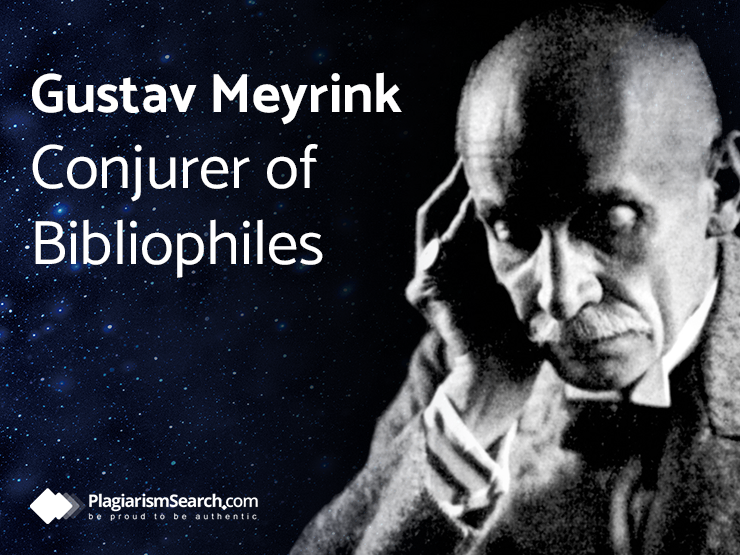
Eerie Magic He Carried Within His Soul and Quills
Gustav Meyrink. The Beginning.
They say “there is Light at the end of the tunnel”, but sometimes, it is life-critical to leave the tunnel before it’s too late.
My favorite author, who fills my mind with farfetched inspiration for cunning storylines, was about to shut his lights out when he was only 24 years old… He could not have become the same whimsical Gustav Meyrink, who is known nowadays (and not known and understood, at the same time…) He could have not started writing his masterpiece 15 years later, as he could have been already dead. However, not only life is unpredictable. Death, as it turned out, can also be generous or at least supremely crafty – all in all, Meyrink’s ensuing storylines were connected to death in its many-faced incarnations. He did not pull the trigger that day in Prague, but that very moment, everything that transcends reality, unveiling otherworldly dimensions, turned into his eerie “ingredients” for the whimsical “intellectual dishes” he made up. Ironically, Death became his Muse.
What made him think about suicide at 24? No one knows it for a fact. There is an allusion my mind gives, “A poetic soul cannot be a banker…” Perhaps, something in his daily life was inconsistent with his inner world. It was wrong for such a person as Meyrink to have an ordinary job in an ordinary world. Making money does not bring delight if you mentally travel somewhere far away each time you set about a tedious routine. Your soul wants to dive into marvelous dimensions of fantasy, discovering whimsical images, playing with eloquence, inventing quasi-realistic situations and characters… but you are forced to pretend to be a middlebrow with usual values, typical thoughts, unpretentious strivings. People who were born to be unusual, think unconventionally, breaking the vicious cycle of philistinism, often cannot find their place in life. I suppose, Meyrink might have suffered from this incessant discord, struggling to break free, and show the world who he genuinely is. Perhaps, he was tormented by some kind of existential crisis, thinking that his life is miserable and meaningless. These are only my guesses. Well, as I have already said, he did not die that day anyway. What happened?
And here is almost the impossible story. His revolver, peacefully lying on the table, was shining in the beams of sunlight. Yet, Gustav’s mind was not calm – it was slightly anxious but determined. He muttered vaguely, “The end is better. Everything leads to the end anyway. The eternal void of the Universe is sedative.” Then he slowly walked up to the table, reaching for the gun. One shot and all the annoying illusions of the least desired reality would disappear. Minutes seemed to be eternal. Finally, the crestfallen man put a revolver to his head. Everything could have ended, but he suddenly heard a sound of a paper skimming along the floor. The sound of paper sheet rustling that lasted for a second made him put the weapon down. It came from the direction of the door. “A few spare minutes,” he said to himself, and a fragile smile suffused his face. Curiosity won, and he decided to get familiar with his supposedly “final” earthly sign. The surprise surpassed his expectations, as he was looking at a booklet called “The Afterlife”. It startled him. What an esoteric symbolism! Even if it was a mere coincidence, it alluded that it was too early to shut lights out. Perhaps, he would not have paid attention to this sign if he had not been a member of a secret London society entitled “the Hermetic Order of the Golden Dawn”. This eerie organization was dedicated to investigations of metaphysical matters and paranormal activities. They were especially active during the late 19th and early 20th centuries. Were they modern magicians of the then era or explorers of everything beyond the ordinary human perception? I can leave this question for your own revelations. The most important thing is that Meyrink was both a banker and a believer in the occult – which constructed his personal oxymoron; he was someone existing on the verge of natural and supernatural. So, did he actually believe in afterlife when he decided to commit suicide, was he sure that other dimensions are real? Why then he changed his mind because of the brochure that alluded to higher spiritual forces that protect him? Who was that life-saving stranger behind his door? Was it somehow planned or predicted by the secret society? Was it a sheer coincidence? Such questions can be incessant. However, the event brought a marvelous metamorphosis – it turned Gustav into the sorcerer of the quill.
From that moment on, he immersed in studying ancient philosophies that centered around various interpretations of the spiritual realm. He delved into Christian Sophiology, Kabbala, Eastern mysticism, and even alchemy. If you are not even slightly interested in mystic knowledge, you will not be able to delve into the labyrinths of obscure symbols and paradoxes generated by Meyrink. The reading experience you gain is valuable only when you are ready for the awkward challenges the author invented for curious minds. If to refer to his comprehension of this obsolete science, his way of thinking will likely surprise you. He never deemed it a practical science, but he once said that alchemy is “a cherished art of kings, which is able to transmute a human being, his dark and marcescible nature into the Eternal, sacramental, and perpetually conscious creature”. Hence, the alchemy is not a transmutation of metals, not the desire to obtain a cherished gold from plumbum, but a metaphysical experience of human reincarnation into a higher being.
The Expressionist Yogi
I can easily imagine him meditating and practicing yoga, which helped him “catch” an abundance of literary insights. Nevertheless, you have to keep in mind that Meyrink was predominantly an author, and then a philosopher. You may call him an amateur or even a charlatan, but he did not create esoteric teachings – he was inspired by them and transferred them into fiction. That is why Gustav Meyrink is not for those readers who prefer realism. If to choose simple terms, the genres he worked with encompassed fantasy and horror, but they do not embody the “usual horror stories”, not even those of the famous Father of Gothic Fiction – Edgar Allan Poe. Since his prose is often filled with specific emotional tone of a storyteller, so you can even imagine the scars on his face and the madness or tranquility in his eyes, it perfectly adheres to the genre of expressionism. Each Meyrink’s narrator is like a prophet of “arcane things to come”. If you could paint his grotesque symbols, especially the ghastliest ones, they would resemble the characters from the artworks by Alfred Kubin – no wonder, they were friends and, apparently, inspired each other. In one of Meyrink’s short stories “The Sunstroke”, he depicted himself and Kubin, drinking wine and arguing about the existence of the devil. Alfred expresses an enticing thought that devil exists because he can paint him – and any artist cannot paint something inexistent. He means that what seems to be mythical is real as long as you can imagine it. Though Gustav, at the beginning of this story is allegedly against such a theory, calling it “odium theologicum”, he gradually divulges that everything whimsical belongs to the supersensible – at times, you get confused whether it truly happened to you, but it does not mean it did not happen.
It proves Meyrink is a surrealist as well, erasing the borderlines between dreams and reality. Sometimes, he is even more surreal than the famous Dali, but his images have remained in his words. His fantasy is magical, woven by caricatures, mystic mind journeys, and staggering juxtapositions. There is a thread of Duality in his thoughts. Frequently, he questions the variability of his own experience.
In the above-mentioned work, he writes about an enigmatic figure of his supposed acquaintance, doctor Sacrobosco Hazelmayer. He puzzles the reader, saying he was writing about this subject many times in order to get rid of him. Then he started doubting whether this person is real at all. Anyway, this character becomes tangible in “The Sunstroke”, appearing before the readers “eyes” and proving his existence. The experience with Sacrobosco remains surreal, and when reading about him, you get a feeling that you are inside somebody’s dream.
In my next article about Gustav Meyrink, you will travel in the past, walking along the riddled places of old Prague. You will understand why this Bohemian city was so special for this unique author, and why it is deemed a “threshold between the visible and the unseen worlds.”.
“Prague does not have its name for no reason – in truth, Prague is a threshold between the life on Earth and Heaven, a threshold much thinner and narrower then in any other places…” ― Gustav Meyrink
To be continued…



